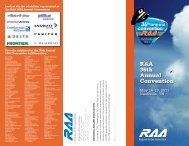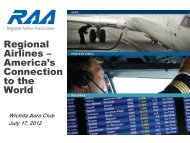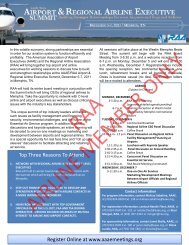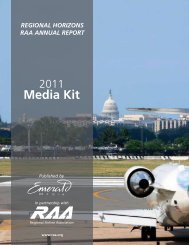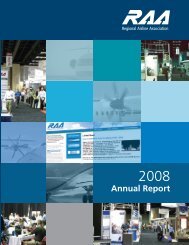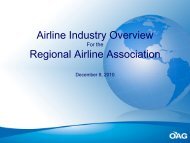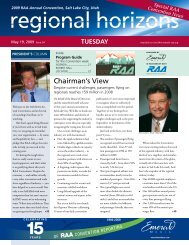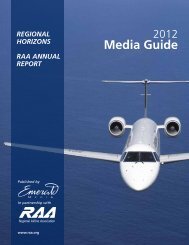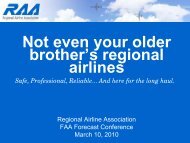Comments - Regional Airline Association
Comments - Regional Airline Association
Comments - Regional Airline Association
Create successful ePaper yourself
Turn your PDF publications into a flip-book with our unique Google optimized e-Paper software.
100% accessible automated kiosks at an airport. Forexample, if we required only 25% of a carrier’sautomated kiosks in an airport location to be accessible,would we also need to require that the carrier givepriority access to any individual who needs an accessiblekiosk?74. At the same time, any mandate to reserve accessibleautomated kiosks at an airport location exclusively forpassengers who need an accessible kiosk carries thepotential of segregating and stigmatizing suchpassengers.75. We nonetheless seek public comment on the need torequire that all new automated airport kiosks beaccessible, and on any alternative approaches we shouldconsider in addition to those discussed above (e.g.,requiring only 25% of a carrier’s automated kiosks in anairport location to be accessible).Applicability76. In light of the overlapping scope of the ACAA and theADA rules, should automated kiosks that are owned,leased, or controlled by carriers and perform functionssimilar to airport kiosks, but are located in non-airportvenues (e.g., hotel lobbies), be covered in thisrulemaking?Effective Date - Kiosks77. Should the proposed time frame for accessible kiosks(i.e., kiosks ordered 60 days after the effective date ofthe rule) be reduced or increased assuming the rule iseffective 30 days after publication in the FederalRegister?the final rule would ignore industry efforts needed to create a prototype.Creating a low percentage of accessible kiosk orders would not beproblematic if delayed 36 months. Passengers with disabilities arecurrently able to find accessible bathrooms, airport shuttle services, checkin counters, gates, and other airport services through a variety of means,including airport way finding programs, assistance from travelingcompanions, assistance from carrier or airport personnel, etc.; finding anaccessible kiosk should be no different. Giving passengers with adisability who self-identify priority access to accessible kiosks is a goodpractice.42 There are many examples of separate accessible accommodations to bestserve passengers with a disability and kiosks should be treated nodifferently. Examples include accessible bathrooms, parking spots, seatson mass transit, passenger seats near a gate with accessible logos, etc.42 The best approach is to require no more than 10% of future kiosk orders 36months after the effective date of the rule to be accessible, giving industryenough time to develop a compliant prototype. Requiring all kiosksordered 60 days after the effective date of the final rule would ignoreindustry efforts needed to create a prototype.47 No, Title III already applies to hotels under ADA, conflicting standardsshould not apply.48 As described above, all industry stakeholders agree that the 60 day timeperiod is too short and will set industry up for failure because carriers andmanufacturers will need to develop a prototype before any orders can takeplace. The minimum time period needed is 36 months after the final ruleeffective date; it will take manufacturers one year to develop the prototype,carriers 12 months to develop software, 4-6 months to procure the kiosk,and 6 months to manufacture, install and test software. Any shorter time






